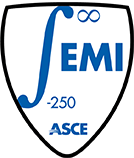Localized Inelastic Strain Modeling
Czech Technical University
Problems
The development of nonlinear fracture process zones precedes the failure of quasibrittle materials (concrete, rock, tough ceramics, bones, ice etc.). These zones can be macroscopically described as regions (typically bands) of highly localized strains. The size and evolution of such localized bands depend on the material's microstructure, in particular on the size and spacing of major heterogeneities. Constitutive models formulated within the classical continuum framework of simple nonpolar materials are not equipped with parameters that capture intrinsic material length scales. Therefore, they are inherently incapable of describing strain localization in an objective and mathematically consistent way. Thus, following the loss of ellipticity, their application leads to ill-posed boundary value problems. Numerical solutions then exhibit a pathological sensitivity to the spatial discretization, e.g. the size of finite elements.
Approach
We adopt the perspective that a number of different models provide a remedy to capture narrow zones of highly concentrated evolving micro-defects: Cohesive zone models admit the presence of a strong discontinuity in the continuum and link the traction transmitted across the discontinuity surface to the displacement jump.
- Smeared crack models consider a localized band of finite thickness, delimited by weak discontinuity surfaces with jumps in strain.
- Regularized models incorporate enrichment terms that restore continuity; but still allow solutions with inelastic processes concentrated in narrow bands.
With a current focus on regularized models that enhance the constitutive description by weighted spatial averages of internal variables or by their gradients, we address the theoretical foundations of such nonlocal models, as well as their efficient numerical implementation. For concrete and bone, we recently completed an integral-type nonlocal formulation of a damage-plasticity model.
Findings
Based on a three-invariant yield condition in the effective stress space, non-associated flow rule, and plastic hardening law, this damage-plasticity model captures not only the pre-peak behavior, but also the softening behavior by means of a damage variable driven by the plastic flow. Hereby, the nonlocal extension uses a combination of local and nonlocal cumulative plastic strain as the damage-driving variable. This model provides an objective description of failure, even in cases when diffuse and localized damage zones develop simultaneously in different parts of the specimen. The nonlocal damage-plastic model, originally developed for concrete, is also adapted to trabecular bone. Anisotropy of this porous material is considered through a fabric tensor deduced from morphological data obtained by microtomography.
Impact
For engineering applications, regularized models provide an objective description of the complete failure process, both prior to and after strain localization. The implementation of such models greatly enriches the predictive capabilities of engineering simulation tools. Before such models can be routinely used in practice, their behavior must be fully understood and all details of the formulation must be tuned up, such that the results of simulations remain reliable and accurate; to ultimately meet the increasing demand of most complex and challenging engineering applications.
Core competencies
- Modeling of inelastic material behavior based on viscoelasticity, plasticity, damage and fracture mechanics.
- Integral-type and gradient-type nonlocal continuum theories.
- Development of an object-oriented platform for computational mechanics coupled with transport problems.
Current research team members
- Milan Jirásek (Professor)
- Bořek Patzák (Associate Professor)
- Jan Zeman (Associate Professor)
- Václav Šmilauer (Ph.D. Candidate)
- Martin Horák (Ph.D. Candidate)
- Petr Havlásek (Ph.D. Candidate)
- Ondřej Rokoš (Ph.D. Candidate)
Recent graduates and co-workers
- Denis Davydov (Ph.D. 2010)
- Mathieu Charlebois (Post-Doctoral Research Associate 2008-2009)
Current research collaborations
- Creep and hygrothermal effects in concrete structures: Zdeněk P. Bažant (Northwestern University)
- Bone mechanics: Philippe Zysset and Dieter Pahr (Vienna University of Technology)
- Meso-mechanical modeling of concrete: Peter Grassl (University of Glasgow)
- Mathematics of regularized models: Tomáš Roubíček (Charles University, Prague)


